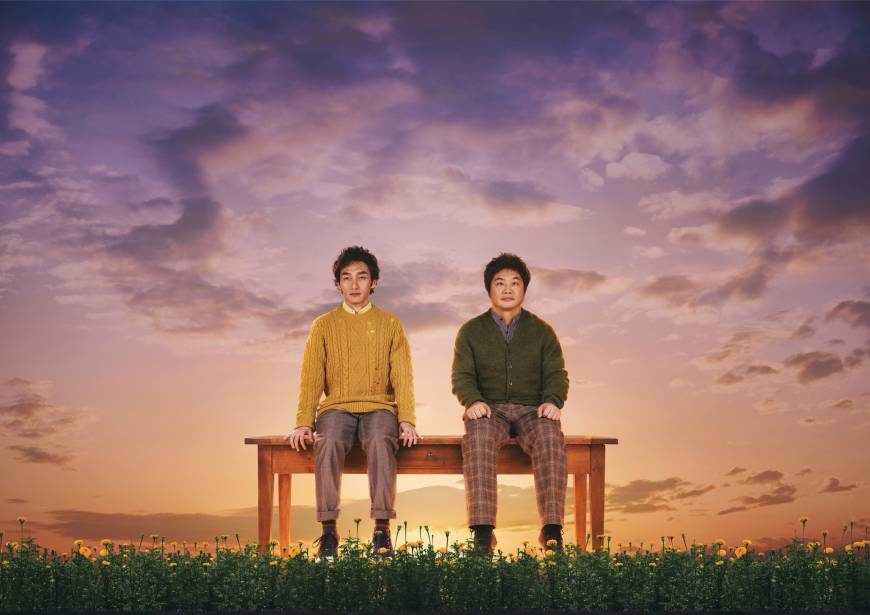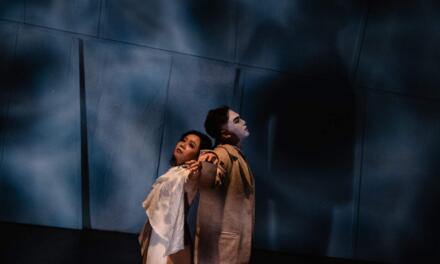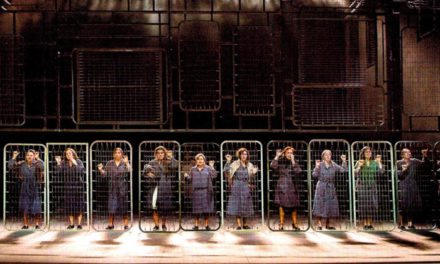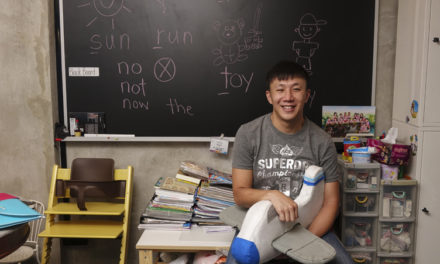When Akira Shirai first read the script for Ballyturk, he quickly understood why its creator, Irish playwright Enda Walsh, said the work, “should bypass the intellect and go straight into your bones.”
The 60-year-old artistic director at Kanagawa Arts Theatre in Yokohama was mulling over what to stage next and he says the hilariously absurd piece, with its three-person cast of characters named One, Two and Three, left him somewhat dumbfounded.
“I said as much to the translator, Chizuko Komiyama, who then told me she didn’t get it either,” the director says with a laugh. “Yet somehow it just stuck with me, so I chose it without having to think twice.”
Walsh, 51, who also scripted the late David Bowie’s 2015 musical Lazarus, premiered Ballyturk at the Galway International Arts Festival in 2014. It was then staged at a few other venues in Ireland ahead of well-received runs in London and New York.
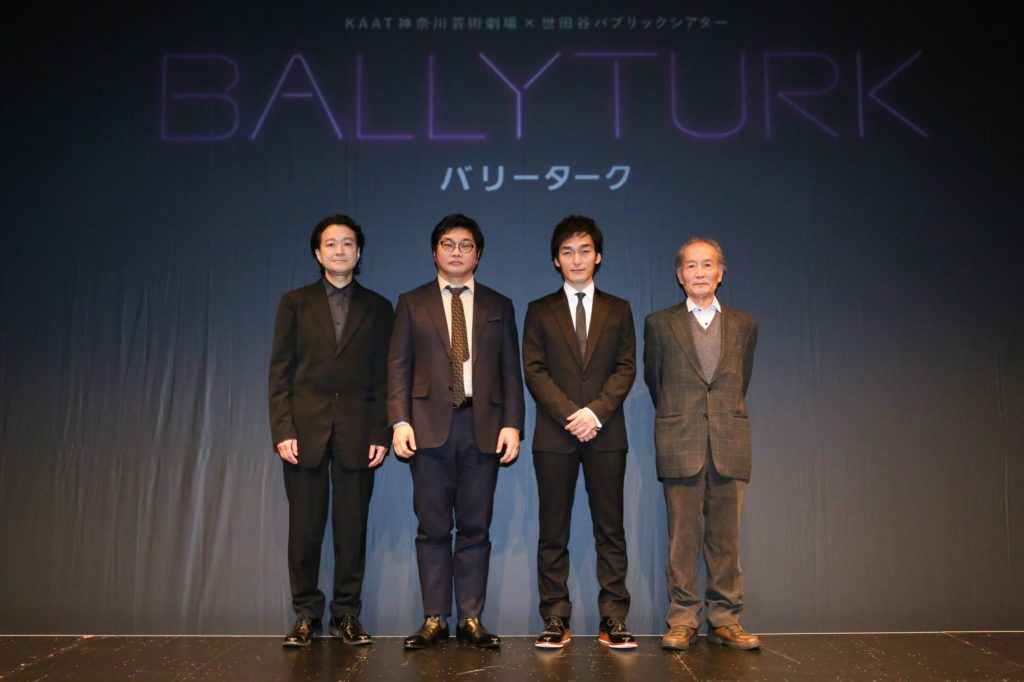
Small cast: Director Akira Shirai (far left) poses with actors Satoru Matsuo, Tsuyoshi Kusanagi, and Katsuya Kobayashi at a press conference for his play, Ballyturk.
Shirai’s production will open in Yokohama before moving to Tokyo and Nishinomiya, Hyogo Prefecture. The play has scored Tsuyoshi Kusanagi, formerly of the mega-pop group SMAP, for the role of One. Luckily, his casting doesn’t overshadow the story, which starts out with One and Two (Satoru Matsuo) living rather mundane lives in a shared room that has a smattering of furniture, a record player, and a bunch of balloons. The pair change their clothes, listen to 1980s pop music and imagine themselves as the citizens of an imaginary village they call Ballyturk, and when they’re done they do it again.
“When I first began reading the script, the two men were just repeating their routines over and over,” Shirai says. “Yet I was amazed by this kind of daring, ’empty’ approach. I started to notice how this play depicts my own, or anyone’s, life. After all, we usually see life as very complicated, that we need to make difficult decisions at every turn. However, we actually inhabit worlds that are rather closed, and we engage in the same routines over and over.”
Eventually, One and Two begin hearing voices through the wall, which soon opens to reveal an older person, Three (Katsuya Kobayashi), who tells them the time has come for one of them to leave the room.
“I think everyone is represented by either One or Two,” Shirai says. “One is constantly trying to break through the wall to see what’s there—maybe that’s an afterlife—while Two tries to ignore that wall.”
At the end of Ballyturk, Walsh has a young girl (who may or may not be from our world) visit the remaining character, who grieves alone in the now somber room. The audience is left with the feeling, however, that life, no matter how fleeting, goes on.
Shirai has staged many large productions in his career—Broadway musicals such as The Addams Family; Japan premieres of Philip Ridley’s The Pitchfork Disney and Mercury Fur; adaptations of The Music Of Chance and Ghosts by novelist Paul Auster—but he says Ballyturk is unlike anything he’s ever done.
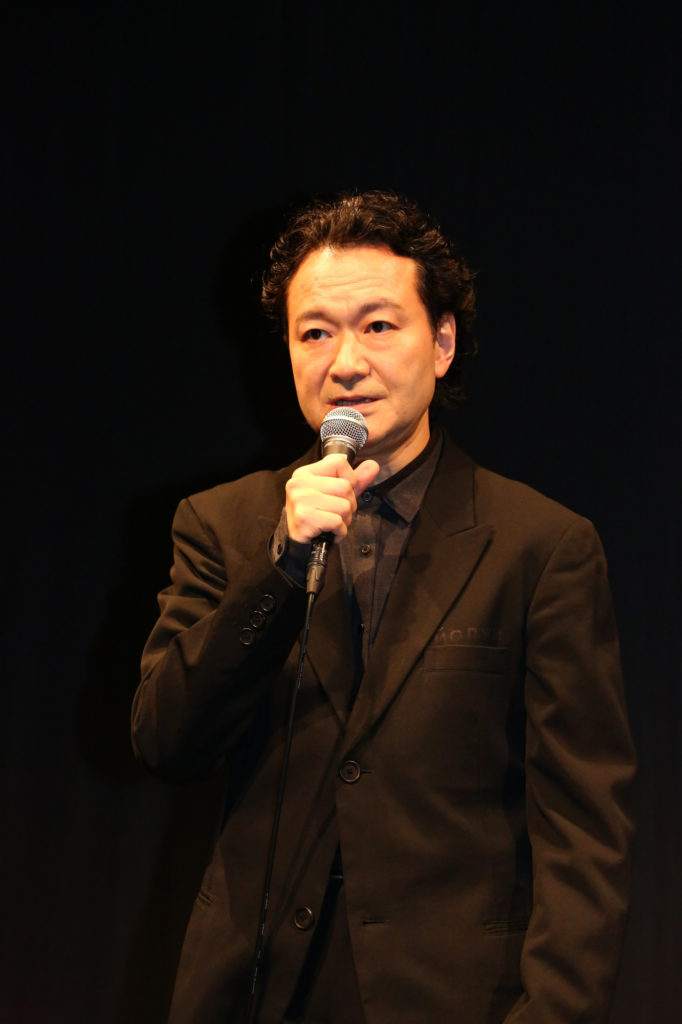
Strange brew: Akira Shirai didn’t quite understand what Ballyturk was about at first, but then he realized that everyone could relate to one or the other of the two main characters.
He even goes so far as to describe Ballyturk as the modern equivalent of Samuel Beckett’s 1953 play Waiting For Godot. That’s praise indeed since that minimalist work was voted the “most significant English-language play of the 20th century” in a 1990 poll by the Royal National Theatre in London.
“However, while in Waiting For Godot two men wait in vain for Godot, in Walsh’s play Three appears in front of One and Two as an apparent herald of mortality. Also unlike Beckett’s masterpiece, Ballyturk features a lot of slapstick and a pop atmosphere,” Shirai says.
Shirai wasn’t the only one who thought Ballyturk was challenging, as he says the actors had to work hard at the piece every day during rehearsals.
“Kusanagi said it was precisely because he didn’t understand the content at all that he accepted the part,” Shirai says. “Perhaps having just started his new career after his pop group broke up in 2016 may have motivated him to take the plunge. But he also said that he likes to put extra effort into whatever he does, and I can really see that in his portrayal of One.”
Ballyturk didn’t just present an artistic challenge to the director, Shirai is also using it to figure out a new business model when it comes to putting on plays. So, rather than competing with other public theaters in the metropolitan region as Kanagawa Arts Theatre used to do, this play is being staged jointly in collaboration with Setagaya Public Theatre, which is based in Tokyo.
“When I started working with KAAT in 2014, I found I was trying to pull audiences in from Tokyo as well as from our immediate vicinity of Yokohama,” Shirai says. “But I realized siphoning off the Tokyo crowds would be a long process, so I changed my policy and started seeking out business partners there instead.
“In terms of spreading theater culture in Japan it’s silly to have turf wars. We need to all work together to extend our reach, but we haven’t done that before due to the inertia of the bureaucrats who run these public theaters.”
Shirai thinks this new method of cooperation will turn out to be more cost-efficient. He was surprised that arranging everything wasn’t as difficult as he thought it would be, and figures that people before him had just been too lazy to give it a try.
“I am not one of KAAT’s staff members, who were a little unsure about me taking this different approach in the beginning. However, I just stressed that it was all about making KAAT a fresher, more influential theater—and I think that, as artistic director, I must try to do these kinds of things,” Shirai says. “How else are we going to get live theater into the bones of people here in Japan?”
Ballyturk runs April 14-May 6 at Kanagawa Arts Theatre in Yokohama; May 12-25 at Setagaya Public Theatre’s Theatre Tram in Tokyo; and on June 16 and 17 at Hyogo Performing Arts Center in Nishinomiya. For details, call KAAT on 0570-015-415 or SEPT on 03-5432-1515 or visit www.kaat.jp or www.setagaya-pt.jp.
This article originally appeared in Japan Times on April 11, 2018, and has been reposted with permission.
This post was written by the author in their personal capacity.The opinions expressed in this article are the author’s own and do not reflect the view of The Theatre Times, their staff or collaborators.
This post was written by Nobuko Tanaka.
The views expressed here belong to the author and do not necessarily reflect our views and opinions.

